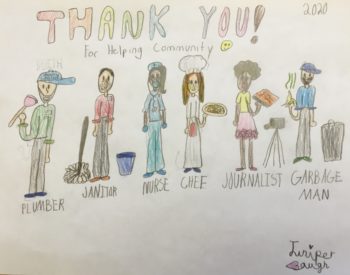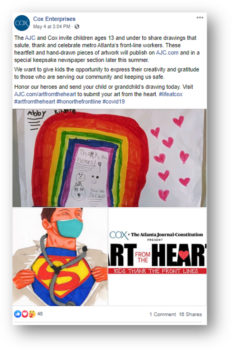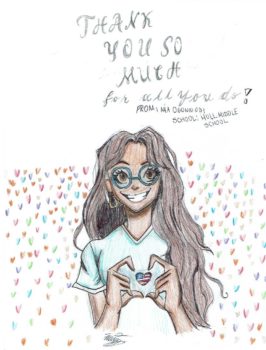How the Atlanta Journal-Constitution engaged the community to thank front-line workers and generated $35,000 in advertising revenue along the way
Mark A. Waligore, Managing editor and senior director,This is a series on Better News to a) showcase innovative/experimental ideas that emerge from the Knight-Lenfest Newsroom Initiative and b) to share replicable tactics that benefit the news industry as a whole. This “win” comes from Mark A. Waligore, managing editor and senior director at The Atlanta Journal-Constitution, which participated in the UNC Knight Foundation Table Stakes Newsroom Initiative in 2019-20.
Question: What problem were you trying to solve, and why was solving the problem strategically important for your organization?
Answer: We knew we had an important role to keep our community informed with vital information and in-depth reporting about the coronavirus. But part of our journalistic mission includes shining a spotlight on people and positive stories that inspire Atlanta.

This picture was drawn by Juniper, 8. (Submitted to the AJC)
We were struck by the wave of gratitude that had been sweeping across our city — and we were looking for a way to tap into that sentiment. We also had been trying to identify some “counter-programming” to the gloom-and-doom news that had been weighing so heavily on everyone since March.
Of course, the pandemic also had an impact on advertising. At the time, revenue was off 49 percent year over year. Art from the Heart provided an alternative. Approaching our advertisers to support this cause rather than just asking for advertising dollars felt right. Even if advertisers could not support Art from the Heart because of financial reasons, we received positive feedback and encouragement from them. And those that did support the initiative received positive feedback from their customers and community.
Q: How is this approach related to Table Stakes (e.g. one of the 7 Table Stakes and/or an outgrowth of the Knight-Lenfest initiative, etc.)?
A: This idea is related to Table Stake No. 6 (“Partner to expand your capacity and capabilities at lower and more flexible cost”) and Table Stake No. 7: Drive audience growth and profitability from a “mini-publisher” perspective.
Q: How did you go about solving the problem?
A: We knew it was important to celebrate everything that makes our community so strong — and do our part to thank those on the front lines. But with so many of our trained journalists dedicated to coronavirus coverage, we just didn’t have the capacity to embark on an ambitious undertaking.
Inspired by the work of our community contributors — readers who have been sharing uplifting, first-person stories during the pandemic — we decided to turn to the community to expand our capacity.

One of the Art from the Heart ads distributed on Facebook. (Submitted by the AJC)
The idea behind the project came during a brainstorming session between our advertising team and key personnel in the newsroom. The more we talked about the idea, the more powerful it became. When our marketing department floated the name — “Art From the Heart” — we realized that we might be onto something.
Leaning on our Table Stakes learnings, we followed the “mini-publisher” model, forming a team of nearly 15 people from marketing, advertising and the newsroom who met weekly leading up to launch.
We ran solicitations on AJC.com, asking readers to send their child’s submission. We were deliberate in asking children to remember all front-line workers, not just doctors and nurses. After all, we felt it was important to represent the many occupations — such as postal carriers, police officers, firefighters, grocery store workers, trash collectors and delivery people — that were making sacrifices on the community’s behalf.
Over the next several weeks, we ran 16 ads in print, we published three stories in our newspaper, and we ran solicitations on AJC.com. We also launched a robust Facebook campaign, which generated 164,000 impressions. Here are some examples of our Facebook campaign:
It didn’t take long for the submissions to begin rolling in. We asked parents to fill out a simple form and upload their child’s drawing, making it all very easy on our end.
Q: What worked?
A: All in all, we viewed the project as a success. To date, it has generated 56,000 page views, and we’ve had nearly 8,000 users interact with the content on AJC.com. We also saw more than 7,000 engagements from our Facebook campaign. And we generated $35,000 in revenue in the eight weeks leading up to publication.

This picture was drawn by Mia, 12. (Submitted to the AJC)
The advertisements appeared in print and digital. As you might expect, some came from local hospitals. We also had advertisements from the City of Atlanta — which thanked its heroes for “keeping the city rolling” — the Atlanta Children’s Museum of Art and a company that uses artwork to help organizations raise money.
But the real success can’t be measured by numbers. The project really struck a chord with the community — one of our main goals all along.
We made the decision to “top” Sunday home-delivered newspapers with the section, ensuring that it didn’t get lost in a sea of news. The day after it appeared, we heard from the Carter Center, a not-for-profit organization founded in 1982 by former President Jimmy Carter. The center plans to display the artwork when life returns to normal. The executive director of the Georgia Historical Society also reached out to us, and she plans to include the drawings as part of the historical society’s permanent COVID-19 archives.
Q: What didn’t work?
A: We wish we had been prepared for a larger response. In the end, we were only able to publish 70 of the drawings in a special section that appeared in Sunday’s newspaper. We were able to display every drawing on a special page digitally at www.ajc.com/artfromtheheart/.
Of course, as with any project, we would have liked to have sold more ads. Perhaps if we had waited for the economy to rebound just a bit, we might have driven more revenue. But we felt it was important to share this project with our readers as soon as possible. We were pleasantly surprised at how quickly and easily it all came together. And advertisers were thrilled with the result.
Q: What happened that you didn’t expect?
A: When we first asked for submissions back in May, we never expected that the response would be so overwhelming. Early on, as we tried to imagine what success would look like, we assumed we’d receive perhaps as many as 100 drawings. In the end, 268 children submitted their artwork — some of them as young as 5.
The positive feedback from the community also surprised us. As one reader wrote: “I really like the efforts you’re taking to humanize our hometown newspaper.”
When we promoted the special section on Facebook, other members of the community weighed in, thanking us for displaying the artwork and for expressing our gratitude to so many heroes in our community. In addition to drawing pictures of nurses and doctors, many of the children thanked others who were on the front lines, such as delivery people, trash collectors and, yes, even journalists.
Q: What would you do differently now? What did you learn?
A: Had we known that we would end up receiving so many submissions, we might have explored the possibility of running additional sections over three or four Sundays to accommodate every drawing. (That might have allowed us to generate even more revenue.) Each of the drawings was really that good — and it broke our hearts that we couldn’t include them all in the newspaper.
Although we don’t have any plans to launch a second round of Art From the Heart, we are always searching for ways to engage with the community. Recently, we stumbled upon a story from our friends at the Solutions Journalism Network that looked at how some nursing homes across the country have introduced pen pal programs to help residents cope with social isolation. We’re wondering whether we could partner with a local nursing home and a classroom to begin a pen pal program here in metro Atlanta.
Q: What advice would you give to others who try to do this?

This picture was drawn by Mark A. Waligore, 52, for use in his column. (Submitted to the AJC)
A: Above all else, have as much fun as possible. One Sunday, for instance, I wrote a column about the project and asked for submissions. To accompany the column, I drew my own piece of artwork as a thank-you to those in our newsroom. (Let’s just say it wasn’t nearly as good as the artwork by our younger readers.)
Automating the submission process was so important. As we received drawings, we used them for promotional purposes — which led to even more submissions. We were thrilled when the Carter Center and the Georgia Historical Society contacted us, but I would suggest trying to identify outside partners who might want to display the artwork earlier in the process.
Q: Anything else you want to share about this initiative?
A: Early on, we made the decision to print about 1,550 extra copies of the section so that we could deliver them to hospitals and other front-line partners. Our hope was that they would be able to tuck it away as a keepsake — and that it would serve as a reminder of the community’s appreciation. It was a small investment, but it turned out to be one of the most rewarding aspects of the project. Soon after donating 500 copies to Piedmont Hospital, we received these pictures:

Nurses at Piedmont Hospital pose with complimentary editions of ‘Art From the Heart.’ (Submitted to the AJC)